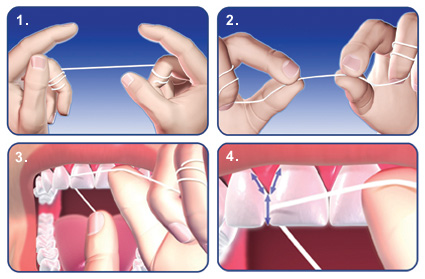Flossing Your Teeth
Flossing is an essential part of dental health. Cleaning between your teeth can help prevent both cavities and gum disease. Brushing your teeth cleans the surfaces of your teeth but it does not reach the spaces in between where plaque also builds up. This is why dentists recommend brushing and flossing everyday. When flossing, it is important to do it correctly. Believe it or not, there is a wrong way to floss! Watch the video below to learn the proper techniques for flossing.
How to Floss

1. Take about 18 inches of waxed floss and wrap around your middle fingers.
2. Leave about 2 inches of floss in between your middle fingers. Use your thumb and first finger to guide the floss in between your teeth.
3. Wrap the floss around the tooth in a C-shape , almost like the floss is hugging the tooth.
4. Wrap the floss up high near the gums in a Y-shape like in image 4.
2. Leave about 2 inches of floss in between your middle fingers. Use your thumb and first finger to guide the floss in between your teeth.
3. Wrap the floss around the tooth in a C-shape , almost like the floss is hugging the tooth.
4. Wrap the floss up high near the gums in a Y-shape like in image 4.
Flossing this way removes the most plaque off of your teeth. Any left over food on the teeth gets turned into acids by the bacteria in your mouth. These acids are what cause dental decay or cavities. Floss once a day to help prevent cavities and gum disease!
Flossing Your Child's Teeth
Begin flossing your child's teeth as soon as the teeth start to fit close together. Baby teeth are important! Children need healthy teeth so they can comfortably eat and talk. Baby teeth also hold the space for adult teeth. If a child loses a tooth prematurely it can negatively affect how the adult teeth grow in. Children need help flossing their teeth from an adult until they are at least ten years old! Below is a quick video with tips on how to floss your child's teeth.
